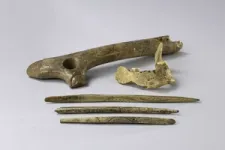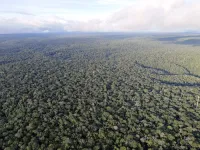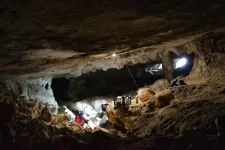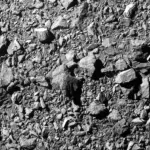(Press-News.org) The team analysed the genomes of 356 prehistoric hunter gatherers from different archaeological cultures – including new data sets of 116 individuals from 14 different European and Central Asian countries. Modern humans began to spread across Eurasia around 45,000 years ago but previous research showed that the first modern humans that arrived in Europe did not contribute to later populations. This study focuses on the people who lived between 35,000 and 5,000 years ago and that are, at least partially, the ancestors of the present-day population of Western Eurasia, including – for the first time – the genomes of people who lived during the Last Glacial Maximum (LGM), the coldest phase of the last Ice Age, around 25,000 years ago.
Climatic refugium or dead end?
Surprisingly, the research team found that populations from different regions associated with the Gravettian culture, which was widespread across the European continent between 32,000 and 24,000 years ago, were not closely related to each other. They were linked by a common archaeological culture: they used similar weapons and produced similar portable art. Genetically, however, the populations from western and southwestern Europe (today's France and Iberia) differed from contemporaneous populations from central and southern Europe (today's Czech Republic and Italy).
Furthermore, the gene pool of the western Gravettian populations is found continuously for at least 20,000 years: their descendants who are associated with the Solutrean and Magdalenian cultures stayed in southwestern Europe during the coldest period of the last Ice Age (between 25,000 and 19,000 years ago) and later spread north-eastward to the rest of Europe. "With these findings, we can for the first time directly support the hypothesis that during the Last Glacial Maximum people found refuge in the climatically more favourable region of southwestern Europe" says first author Cosimo Posth.
The Italian peninsula was previously considered to be another climatic refugium for humans during the LGM. However, the research team found no evidence for this, on the contrary: hunter-gatherer populations associated with the Gravettian culture and living in central and southern Europe are no longer genetically detectable after the LGM. People with a new gene pool settled in these areas, instead. "We find that individuals associated with a later culture, the Epigravettian, are genetically distinct from the area‘s previous inhabitants," says co-author He Yu. "Presumably, these people came from the Balkans, arrived first in northern Italy around the time of the glacial maximum and spread all the way south to Sicily."
Large-scale genetic replacement
The analysed genomes also show that the descendants of these Epigravettian inhabitants of the Italian peninsula spread across the rest of Europe about 14,000 years ago, replacing populations associated with the Magdalenian culture. The research team describes a large-scale genetic replacement that may have been caused, in part, by climatic changes that forced people to migrate: "At that time, the climate warmed up quickly and considerably and forests spread across the European continent. This may have prompted people from the south to expand their habitat. The previous inhabitants may have migrated to the north as their habitat, the ‘mammoth’ steppe, dwindled," says Johannes Krause, the study's senior author.
Furthermore, the findings show that there had been no genetic exchange between contemporaneous hunter-gatherer populations in western and eastern Europe for more than 6,000 years. Interactions between people from central and eastern Europe can only be detected again from 8,000 years ago. "At that time, hunter-gatherers with distinct ancestries and appearances started to mix with each other. They were different in many aspects, including their skin and eye colour," says He Yu.
During this time agriculture and a sedentary lifestyle spread from Anatolia to Europe. "It is possible that the migration of early farmers into Europe triggered the retreat of hunter-gatherer populations to the northern edge of Europe. At the same time, these two groups started mixing with each other, and continued to do so for around 3,000 years," Krause says.
"The data we gained from this study provides us with astonishingly detailed insights into the developments and encounters of West Eurasian hunter-gatherer groups," Posth summarises. "Further interdisciplinary research will clarify which exact processes were responsible for the genetic replacements of entire Ice Age populations.”
END
Ice Age survivors
Large-scale genomic analysis documents the migrations of Ice Age hunter-gatherers over a period of 30,000 years – they took shelter in Western Europe but died out on the Italian peninsula
2023-03-01
ELSE PRESS RELEASES FROM THIS DATE:
Deforestation in the tropics linked to a reduction in rainfall
2023-03-01
Projected deforestation in the Congo could result in a 12% reduction in rainfall
Study provides “compelling evidence” to protect forests
Deforestation is resulting in reduced rainfall across large parts of the tropics, according to new research.
People living in tropical forest communities have often complained that the climate gets hotter and drier once trees are cleared but until now, scientists have not been able to identify a clear link between the loss of tree cover and a decline in rainfall.
A research team at the University of Leeds combined satellite data of deforestation and rainfall to show ...
Quantum chemistry: Molecules caught tunneling
2023-03-01
Tunneling reactions in chemistry are very difficult to predict. The quantum mechanically exact description of chemical reactions with more than three particles is difficult, with more than four particles it is almost impossible. Theorists simulate these reactions with classical physics and must neglect quantum effects. But where is the limit of this classical description of chemical reactions, which can only provide approximations?
Roland Wester from the Department of Ion Physics and Applied Physics at the University of Innsbruck has long wanted to explore this frontier. “It requires an experiment that allows very precise measurements and ...
New study could help pinpoint hidden helium gas fields – and avert a global supply crisis
2023-03-01
Helium – essential for many medical and industrial processes – is in critically short supply worldwide. Production is also associated with significant carbon emissions, contributing to climate change.
This study provides a new concept in gas field formation to explain why, in rare places, helium accumulates naturally in high concentrations just beneath the Earth’s surface.
The findings could help locate new reservoirs of carbon-free helium – and potentially also hydrogen.
Research led by the University of Oxford could help overturn the current supply crisis of helium, ...
Unique alcohol avoidance program is associated with lower death rates
2023-03-01
A statewide alcohol-monitoring program that requires people arrested for drunk driving and other alcohol-involved offenses to be tested frequently for alcohol use can reduce the likelihood that participants die for several years after their involvement with the program, according to a new RAND Corporation study.
Analyzing results from South Dakota’s 24/7 Sobriety Program, researchers found that those arrested for drunk driving who participated in 24/7 Sobriety had on the order of a 50% lower risk of dying during the study period compared to those arrested for drunk driving who did not participate in the program..
The results are published in the latest edition of the ...
Outcomes of women undergoing coronary artery bypass surgery
2023-03-01
About The Study: The results of this study of more than 1.2 million patients indicate that women remain at significantly higher risk for adverse outcomes following coronary artery bypass grafting and no significant improvement has been seen over the course of the last decade. Further investigation into the determinants of operative outcomes in women is urgently needed.
Authors: Mario Gaudino, M.D., Ph.D., M.S.C.E., of Weill Cornell Medicine in New York, is the corresponding author.
To access the embargoed study: Visit our For The Media website at this link https://media.jamanetwork.com/
(doi:10.1001/jamasurg.2022.8156)
Editor’s Note: Please see the ...
Reexamining time from breast cancer diagnosis to surgery
2023-03-01
About The Study: This case series study using the data of 373,000 patients from the National Cancer Database found that time from breast cancer diagnosis to surgery of greater than eight weeks was associated with worse overall survival. Time to surgery of greater than eight weeks may partly be associated with disadvantageous social determinants of health.
Authors: Heather B. Neuman, M.D., of the University of Wisconsin School of Medicine and Public Health in Madison, is the corresponding author.
To access the embargoed study: Visit our For The Media website at this link https://media.jamanetwork.com/
(doi:10.1001/jamasurg.2022.8388)
Editor’s ...
Oldest human genome from southern Spain
2023-03-01
An international team of researchers has analysed ancient human DNA from several archaeological sites in Andalucía in southern Spain. The study reports on the oldest genome to date from Cueva del Malalmuerzo in southern Spain, as well as the 7,000 to 5,000-year-old genomes of early farmers from other well-known sites, such as Cueva de Ardales.
The Iberian Peninsula plays an important role in the reconstruction of human population history. As a geographic cul-de-sac in the southwest of Europe, it is on one hand considered a refuge during the last Ice Age with its drastic temperature fluctuations. On the other hand, it may have been one of the starting points for the recolonisation ...
The counting of nine billion trees could help manage climate credits and nature restoration
2023-03-01
Researchers from the University of Copenhagen and NASA have developed a method that has now mapped several billion trees and their carbon uptake in Africa’s Sahel region. In the future, the method could be used to monitor whether climate credit purchases have a positive effect on the number of trees and whether nature restoration is working.
The purchase of indulgences for CO2 emissions is gaining steam among global corporations. Carbon offset credits allow companies to emit a given amount of CO2 in exchange for the greenhouse gas being neutralized elsewhere, in the form of trees planted or left unfelled.
But with billions upon billions of trees across the planet, keeping track ...
New study unveils epigenetic ‘traffic lights’ controlling stop and go for gene activity
2023-03-01
A major new study in the journal Nature reveals a ‘traffic light’ mechanism controlling genetic activity within cells – a system which could potentially be targeted by cancer drugs already in development.
The research describes how ‘epigenetic’ changes to the structure of DNA can act as a stop-go signal in determining whether a gene should be read.
Unlike our genetic make-up, which is well understood, the world of epigenetics is still largely unexplored and referred to as the ‘dark matter’ of the genome.
But the new findings answer a fundamental and longstanding question – how epigenetic proteins regulate the ...
New NASA DART data prove viability of asteroid deflection as planetary defense strategy
2023-03-01
NASA’s Double Asteroid Redirection Test (DART) was Earth’s first attempt at launching a spacecraft to intentionally collide with and deflect an asteroid as a planetary defense technique. On September 26, 2022, the DART spacecraft collided with a small asteroid moon called Dimorphos, which orbits a larger asteroid called Didymos. Neither asteroid posed a threat to Earth, but they represented similar celestial bodies that could one day approach and endanger the planet.
In four papers published in the journal Nature on ...
LAST 30 PRESS RELEASES:
An ECOG-ACRIN imaging study solves a long-standing gap in metastatic breast cancer research and care: accurately measuring treatment response in patients with bone metastases
Cleveland Clinic presents final results of phase 1 clinical trial of preventive breast cancer vaccine study
Nationally renowned anesthesiology physician-scientist and clinical operations leader David Mintz, MD, PhD, named Chair of the Department of Anesthesiology at the UM School of Medicine
Clean water access improves child health in Mozambique, study shows
Study implicates enzyme in neurodegenerative conditions
Tufts professor named Fellow of the National Academy of Inventors
Tiny new device could enable giant future quantum computers
Tracing a path through photosynthesis to food security
First patient in Arizona treated with new immune-cell therapy at HonorHealth Research Institute
Studies investigate how AI can aid clinicians in analyzing medical images
Researchers pitch strategies to identify potential fraudulent participants in online qualitative research
Sweeping study shows similar genetic factors underlie multiple psychiatric disorders
How extreme weather events affect agricultural trade between US states
Smallholder farms maintain strong pollinator diversity – even when far from forests
Price of a bot army revealed across hundreds of online platforms worldwide – from TikTok to Amazon
Warblers borrow color-related genes from evolutionary neighbors, study finds
Heat signaling from plants is an ancient pollinator signal
New index reveals the economics underlying the online manipulation economy
High-resolution satellite observations reveal facility-level methane emissions worldwide
Researchers discover how Ebola and Marburg disrupt the gastrointestinal tract
Feeling the heat
Eastward earthquake rupture progression along the Main Marmara Fault towards Istanbul
Scientists uncover how Earth’s mantle locked away vast water in early magma ocean
Scientists uncover key driver of treatment-resistant cancer
Rare image of Tatooine-like planet is closest to its twin stars yet
Music: Popular song lyrics have become more negative since 1973
Marine ecology: Killer whales tail dolphins to hunt salmon
ADHD prescriptions on the rise, study finds
How to build a genome
Sharp rise in ADHD stimulant prescriptions in Ontario, research finds
[Press-News.org] Ice Age survivorsLarge-scale genomic analysis documents the migrations of Ice Age hunter-gatherers over a period of 30,000 years – they took shelter in Western Europe but died out on the Italian peninsula







